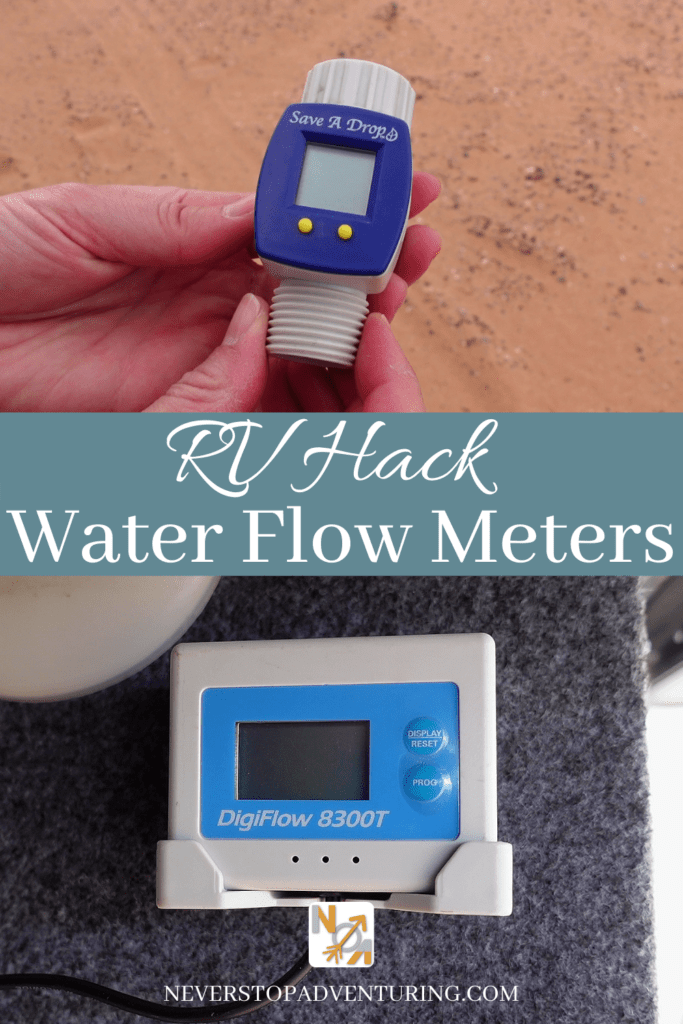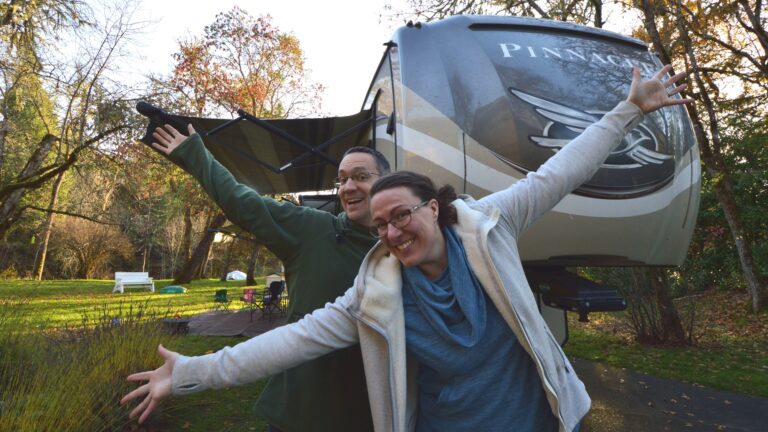RV Tank Sensors Not Working? We Use An RV Water Flow Meter Instead!
Our RV tank sensors have been a real source of frustration. Even if you diligently flush and treat your holding tanks, they can be problematic. Spending a lot of time at full-hookup parks helped us ignore the issue for a while. However, once we were boondocking more we knew we needed a solution. An easy and relatively inexpensive solution was to use a pair of flow meters and we’ll show you how!
DISCLAIMER: This post may contain links to affiliate websites. When you click on and/or make a purchase through an affiliate link placed on our website, we may receive a small commission or other form of compensation at no additional cost to you. Please read our disclaimer for more info.
Standard RV Tank Sensors
Tank sensors are remarkably similar across the RV industry. They are simple electrodes that complete a circuit when the fluid level in your tank comes into contact with them. That gives you the Empty, 1/3, 2/3, and Full readings. It’s also really easy for material in your gray and black tanks to get stuck on them. This can include waste, toilet paper, soap scum, and other debris and other residue. Mineral deposits will also cause false readings.

It is possible to upgrade to something more reliable. The SeeLevel system uses sensors on the outside of your tanks. That eliminates any buildup issues on sensors. We don’t have any experience with this setup, but have heard good things about it. We went a different route because we were looking for a solution that was easier and less expensive.
A Pair of Water Flow Meters
A simple solution that only cost us $110 was to use a pair of water flow meters.
Fresh Water Fill Flow Meter

First, a garden hose water flow meter (https://amzn.to/2SER3RM) lets us know exactly how much water we have put into our freshwater tank. It attaches directly to the water spigot on one end and your fresh water hose attaches to the other and then connects to your RV water fill inlet. You can also use it at a campground without sewer hookups to have an idea as to how much water has gone into your waste tanks.
While it works really well, the plastic housing breaks fairly easily. I just make sure I have my hose set up right where I want it before securing the flow meter to the spigot and the hose to the other end of the flow meter. I broke the plastic housing on the first one I bought by attaching it first and then dragging the hose over to my RV water inlet, oops! So I would just recommend caution in that regard. Though it IS inexpensive after all…
Water Pump Flow Meter

Next, a water filter meter keeps track of how much water we use. The 1/2″ NPT version threaded right onto the pipe from our fresh water tank leading to our water pump. The other end of the flow meter attaches to the water pump inlet via a food grade stainless steel 1/2″ NPT female adapter. Plastic threads going into stainless steel is a quick recipe for cross threading, so be gentle. The display is mounted in the cargo bay on wall opposite the water cabinet. The cable between the water meter and the display is relatively short so I put it nearby for convenience. However, I could have extended the cable and run it up into the bathroom. This is something I considered but once we began using our new setup I didn’t think it was necessary as I habitually check it when filling the dog bowl outside daily.
We set this meter to however much water we put into the fresh tank minus 5. The meter will start beeping when it has counted down to zero, so that means it starts beeping at us when we have 5 gallons left as a warning. We can even hear this beeping inside in our bathroom so we are alerted pretty quickly when we reach this point. This is a good heads up to begin conserving our remaining water a bit more and start planning to dump and refill or visit a full hookup campground.
Holding Tank Capacity
Our holding tank sizes are:
- 65 gallons for fresh water
- 50 for black
- 50 for our first gray tank for the bathroom and clothes washer
- 37 gallons for the second gray tank for the kitchen, including the RV dishwasher we installed.
With our tank sensors not working accurately, we use our setup with the two water flow meters to pay closer attention to how much fresh water we have used. We know our water usage is always distributed between all 3 waste tanks so the water flow meters help us monitor not only the fresh water, but also black and gray holding tanks. That makes this a great solution. The best part is always knowing if there is enough water left for another shower or if we can wash the rest of the dishes before heading to the dump station!
We hope that this post provided you an alternative option if you are also dealing with RV tank sensors that don’t always work properly!
If you liked this post, would you share it with friends? Thank you!
If you’d like to read about our RV and other RV adventures, then check out some of our other posts :
- Emergency RV Repair | Exploring Prescott AZ
- RV Dishwasher Installation
- RV Solar System Lessons Learned
- RV Solar System Installation Series // 2625W of Solar for Off-Grid Boondocking with Air Conditioning
- RV Solar System Installation Series // 7.2kWh Batteries & 6kW Inverter Upgrade
Pin For Later:







